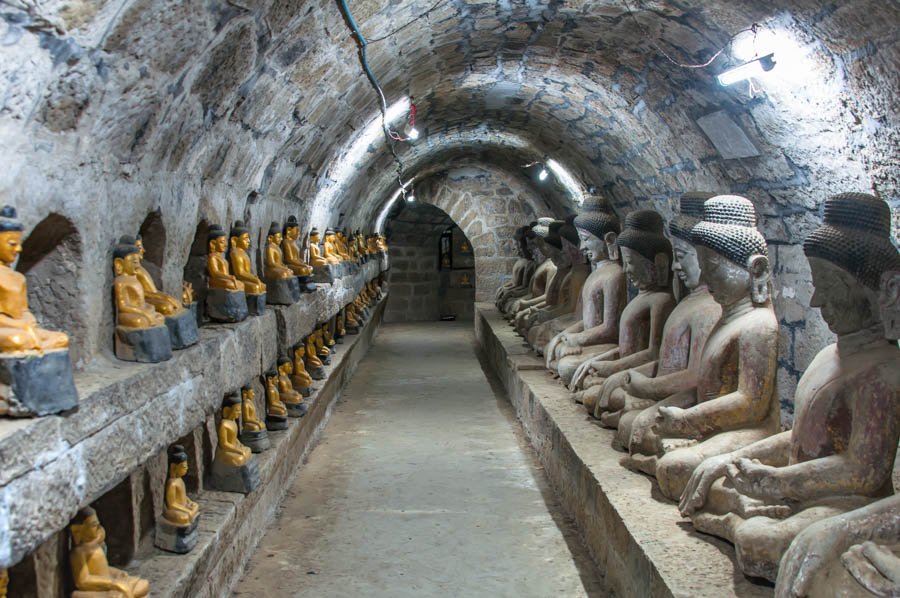Shit-taung Pagoda
Shit-taung means 80,000, which is a rounded number of the 84,000 images enshrined all over India by King Ashoka the Great, who was an Indian emperor of the Maurya Dynasty, and ruled almost all of the Indian subcontinent from c.?268 to 232 BCE. He was a great follower of Buddha’s and spread his teachings throughout the entire Indian subcontinent. Back to present day 1536 when Shit-taung was built by King Min Bin, who we remember came back from exile in Bengal after defeating them, to rule the Mrauk U kingdom. Dr. Pamela Gutman describes Min Bin’s creation of Shit-taung, thus, “A massive Buddhist statement of a Buddhist king who saw himself as a cakravartin, or world conqueror who had triumphed ove rthe forces of Islam…” [Gutman, Pamela – 2001, Burma’s Lost Kingdoms: Splendours of Arakan, Orchid Press, Bangkok,p. 96]. Seems this fight has been going on for centuries.
Architecture and Site
Architectural iconography from Burmese and Late Buddhism of the northwest India characterize and inform much of the building of this pagoda, all in service to the king and his religion. This iconography is also similar to other Southeast Asian monuments coupled with royal cults, a possible cosmic rendering. Shit-taung is built on a mound halfway up the Pokhaung Hill north of the palace site. One enters from the south and walks up a flight of old stone stairs up to the platform of the pagoda.
It seems more cave-like than it actually is, in fact there as no excavation needed, not for that anyway. The elevation is bordered by turret style stupas on the south, north and northwest corners. Another large bell shaped stupa crowns the roof along with four smaller corner stupas and 24 more arranged around the center. Not all of these are any longer original. Restoration was made in the 1920’s and again in the 1950’s after World War 2.
On the north side of the entrance is a massive four-sided pillar of red sandstone. This is the all important stelae inscribed on three sides by Arakan’s rulers describing their prowess as a warrior and king, basically describing the rulers’ histories from the 6th to the 12th centuries.
A three-arched sandstone block screen is similar to mosque architecture of 16th century (or contemporary) Gaur, then the capital of Bengal. Examples include Boro Sona Masjid and Lotan or Lattan Masjid. Both have the same multi-arched faces and surrounded by domes in a series. Three paralled vaulted passageways make it feel as though one is walking through a cave, as mentioned earlier. Although this cave is sunlit and was quite bright in the mid-morning sun when we were there. We were greeted and then pretty much followed around by two very energetic novices who really enjoyed getting their pictures taken.
Inner Passageways Depicting the Three Worlds
These passageways extend from the southeast to the northeast around the central Buddha image, which is itself in an inner shrine, facing east away from a large entrance hall. From here to the outer passage where the wall holds 28 niches each with a life size Buddha. They contain the 28 successive Buddhas of past and present time. Light is coming through, falling on the inner wall. The inner wall is a series of sculpted bas reliefs. According, again, to Dr. Gutman, these reliefs, “can be seen to represent the world of King Min Bin and his perception of himself as a world conqueror or cakravartin, after his military successes in Bengal.” (p. 96) So much for the Buddha’s teachings on dukkha.
The bas reliefs also tells the story of King Ba Saw Pru’s Mahaodhi Shwe Gu, built in the First Phase of Mrauk U Kingdom.
This iconography depicts the microcosm of the Three Worlds which made up the Buddhist universe, the World of Desire, the World with Partial Form and the World without Form. A manuscript entitled ‘Trai Phum,’ written for King Luthai in Sukothai in the mid 14th century provides the material for these iconographic images. The lower five tiers represent the World of Desire as seen by the six heavens of the World of Desire. The sixth tier is the Brahmins’ world or the World of Partial Form. [Gutman, Pamela – 2001, Burma’s Lost Kingdoms: Splendours of Arakan, Orchid Press, Bangkok, p. 96]
